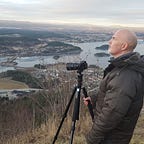The sensor race — Pentax vs Sony
Do we have to always buy the newest camera gear on the market? Does the advances in sensor technology mean that older sensors are obsolete, or are these technological advances just minor upgrades? To what degree will they impact our shooting style and image quality? I wanted to find out.
Introduction
For the past three years I have been a Pentax shooter. I have truly enjoyed the image quality, dynamic range and colors the cameras produce. The K-1 and K-1 MK II are admittedly big and heavy. The built quality is fantastic, though, and so is the weather sealing. I have exposed the cameras for intense waterfall spray and heavy rain without the cameras malfunctioning.
A few months ago I purchased the Sony a7r III to use with the new Tamron mirrorless e-mount lenses.
The Sony has a relatively new backlit sensor, whereas the Pentax’ full frame offerings are, as far as I know, equipped with the same sensor as the Sony a7r.
The Sony is much smaller and lighter than the Pentax. I really like the feel of the camera, the handling and the image quality. The only downside is the weather sealing. It is better, though, than the a7r III’s predecessors, but it isn’t up to par with Pentax.
For some time now I have been keen to find out how much better the backlit sensor is compared to the older Sony sensor. DxO Mark has given the a7r III a sensor score of 100 whereas the Pentax K-1 reached 96. The K-1 Mark II isn’t tested by the website, but I assume it would have scored roughly the same as the K-1.
I want to find out how the two sensors behave when I challenge them, and if this will impact which camera brand I favor for my landscape images.
The Sony a7r III stacked against the Pentax K-1 Mark II, and both cameras underexposed with exactly four stops. It is roughly 15 seconds between the shots since I only brought with me one tripod. Before I begin to compare images, remember that this is not a scientific test which checks all the boxes.
The shoot out
Camera settings: Iso 400, 1/250 sec and f/11.
These are the straight out of camera versions:
I started out with pushing both files four stops in Lightroom, and I also opened up the shadows and blacks. At last I took down the highlights. I used Lightroom’s Sync function to ensure that the settings I applied were equal for both images. Below are the adjusted images.
The result
Without zooming into the images we notice that the Pentax has produced a magenta/warm color shift in the foreground whereas the Sony leans towards a colder tone. Let us have a closer look at the immediate foreground.
Now it begins to become interesting, because the Sony has produced a lot of magenta and green chroma noise. Truth be told, I didn’t see that coming. Next, let us examine that background hill.
Both images are grainy. The chroma noise is still prevalent from the Sony. The Pentax, however, continue to interpret the darkest shadows with a magenta tinge. At last, how much noise and grain are there in the sky?
There is grain in both images, but the Pentax is slightly less grainy at very close inspection in Lightroom. This is not very easy to see on a webpage.
Final thoughts
I cannot draw any definite conclusions based on a limited test like this. However, it seems to me that the Pentax holds up very well compared to the Sony. The outcome isn’t that different when we underexpose and push the files hard in Lightroom.
I have run the Sony image through Topaz DeNoise AI. The program removed almost all the chroma noise. The magenta color cast from the Pentax demands a different approach in post. In Lightroom I went to the Calibration section and set Shadows Tint to -3.
Questions which remain unanswered are for example: What would the result have been if I shot at base iso? How much does the Ricoh accelerator unit improve the final output? According to Digital Camera World the K-1 Mark II has a better dynamic range than the Sony a7r III at all iso settings. The accelerator unit may explain this. The K-1 Mark II also scores better at signal to noise ratio, but the two camera models are equal at iso 400.
Anyway, for me the test means that I can use both cameras as I please without giving image quality a second thought.
